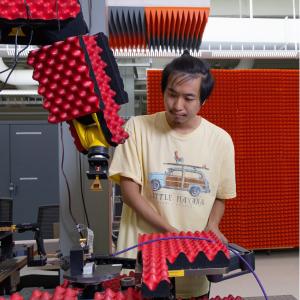
Seung Yoon Lee
What is your background?
Seung Yoon Lee is a Ph.D. student in the School of Electrical and Computer Engineering at Georgia Tech, working in the mmWave Antennas and Arrays Laboratory supervised by Prof. Nima Ghalichechian. He received his B.S. in computer and communication engineering from Korea University, Seoul, South Korea, in 2016, and his M.S. in electrical engineering from the Pohang University of Science and Technology (POSTECH), Pohang, South Korea, in 2018. Prior to Georgia Tech, he worked at Samsung Research and SK Hynix for four years.
Prior academic/industry experience
Seung Yoon Lee completed his master's degree at POSTECH under Prof. Wonbin Hong, introducing the world's first Antenna-on-Display (AoD) concept for mmWave 5G communication. Afterwards, he was required to complete mandatory military service. He was given the opportunity to fulfill this obligation through alternative service by doing several years of research at a top-tier R&D company in Korea. Accordingly, he joined SK Hynix, where he performed numerous cutting-edge SPICE memory model extraction and developed on-chip inductors for high-speed memory products. Later, at Samsung Research, he designed a mmWave Reconfigurable Intelligent Surface (RIS) for next-generation 5G communication technologies.
Why Ph.D.?
During my master's program and subsequent 4 years of industry research, I discovered a passion for identifying and solving problems related to RF, antennas, and metamaterials. Additionally, I was motivated to collaborate with top students in the USA, which led me to leave my previous position at Samsung, despite its positive culture and salary, to pursue a Ph.D. I am in my second year of mentoring undergraduate students at Georgia Tech, driven by a passion for sharing experiences and guiding future engineers. After graduation, I aim to propose and solve intriguing RF-related topics in academia, or in industry, and contribute to cutting-edge research aligned with a company's development direction.
Why Georgia Tech?
I chose Georgia Tech primarily because of my interview with Dr. Nima Ghalichechian, my current advisor, and his expertise in mmWave antenna arrays, aligning with my research interests. I was drawn to Dr. Ghalichechian ‘s lab because their approach of fabricating test samples in-house appealed to me, offering an opportunity to enhance my microfabrication knowledge. Additionally, I aimed to take classes from distinguished professors in my research area, electromagnetics, and collaborate with renowned professors in nanophotonics and electronics. The presence of the Marcus cleanroom, facilitating my microfabrication work, was also a factor in my decision.
Research you’re working on currently & what impact do you believe it will have
The International Telecommunication Union (ITU) predicts global mobile video traffic will account for more than 75% of total mobile traffic by 2030, which is due to the appearance of data-intensive applications such as virtual reality, augmented reality, and high-fidelity mobile holograms. In order to prepare for the potential huge increases in throughput, research on antennas operating at mmWave (30-300 GHz) band communications is being actively conducted which is thanks to its wide range of channel bandwidths available compared to the conventional microwave (i.e. < 3 GHz) band.
I aim to develop a highly efficient electronically scanned on-chip antenna array operating in the mmWave band, incorporating low-loss vanadium dioxide switches through monolithic integration. The objective is to design, fabricate, and characterize a V-band on-chip electronically scanned array for mmWave high data-speed wireless systems. This approach addresses the fundamental challenge of conventional low-efficient on-chip antenna arrays for next-generation 5G and 6G communications.
Tell us about anything else you wish to share like a personal hobby or talent
To manage stress, I watch MLB or other sports games and play soccer on special occasions. I enjoy exploring new places in the United States that I've not been to, such as New York, Miami, and San Francisco.
